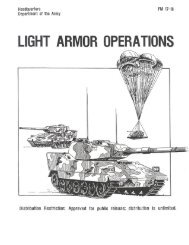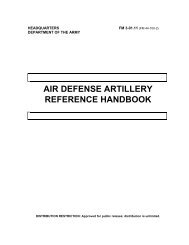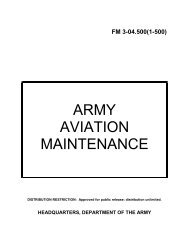fm 44-100 us army air and missile defense operations
fm 44-100 us army air and missile defense operations
fm 44-100 us army air and missile defense operations
Create successful ePaper yourself
Turn your PDF publications into a flip-book with our unique Google optimized e-Paper software.
FM <strong>44</strong>-<strong>100</strong><br />
4-18<br />
combatant or joint force comm<strong>and</strong>er will establish the sequence in which<br />
Army units should deploy relative to the movement of forces of the other<br />
services. ADA comm<strong>and</strong>ers m<strong>us</strong>t prioritize deployment sequences consistent<br />
with METT-TC. ADA comm<strong>and</strong>ers <strong>us</strong>e available time to complete training<br />
<strong>and</strong> certification as well as building team cohesion. For forward presence<br />
forces, it may be necessary to provide <strong>air</strong> <strong>defense</strong> force protection <strong>and</strong><br />
counter-RSTA during this stage.<br />
STAGE THREE -- DEPLOYMENT<br />
4-96. ADA units are trained, structured, <strong>and</strong> postured for rapid deployment.<br />
Deployment planning tools, described in FM 55-65, allow comm<strong>and</strong>ers to<br />
adapt to rapidly changing circumstances. Lift assets are limited, but critical<br />
to the successful projection of the force. ADA comm<strong>and</strong>ers make every effort<br />
to integrate the capabilities of the host nation, joint <strong>and</strong> multinational forces,<br />
<strong>and</strong> forward presence forces with those of the deploying force. Comm<strong>and</strong>ers<br />
m<strong>us</strong>t balance the factors of METT-TC against available lift assets to<br />
determine the composition of the initial response force. Each crisis will have<br />
unique dem<strong>and</strong>s, ca<strong>us</strong>ing comm<strong>and</strong>ers to balance requirements against lift.<br />
In deployment, comm<strong>and</strong>ers m<strong>us</strong>t maintain versatility <strong>and</strong> agility in force<br />
mix, their combat capability, s<strong>us</strong>tainment, <strong>and</strong> lift, along with the need to<br />
forecast future events that call for decisions early in the deployment stage.<br />
4-97. ADA comm<strong>and</strong>ers are responsible to provide forces protection during<br />
deployment. They m<strong>us</strong>t tailor the force to accomplish the mission against the<br />
threat developed during IPB. They may have to sacrifice mobility, redundant<br />
communications, <strong>and</strong> s<strong>us</strong>tainability to bring in sufficient firepower to protect<br />
the force <strong>and</strong> designated assets during the initial phases of the deployment.<br />
Counter-RSTA will also be a significant part of the responsibilities of the<br />
ADA comm<strong>and</strong>ers, especially with respect to UAVs. Protection of joint <strong>air</strong> <strong>and</strong><br />
<strong>missile</strong> <strong>defense</strong> priorities may outweigh <strong>defense</strong> of service priorities.<br />
STAGE FOUR -- ENTRY OPERATIONS<br />
4-98. The requirements of entry <strong>operations</strong> will vary. Each operation will be<br />
different. Entry may be either opposed or unopposed. Forces are most<br />
vulnerable <strong>and</strong> the success of the operation at greatest risk during initial<br />
entry. This vulnerability is most acute when the enemy possesses weapons of<br />
mass destruction. Defensive <strong>and</strong> offensive <strong>operations</strong> to counter these<br />
weapons will affect ADA, Army, joint, <strong>and</strong> multinational planning. Protecting<br />
the entry force will be critical to the success of this phase of the operation.<br />
4-99, Continuo<strong>us</strong> intelligence support is critical. Entry force comm<strong>and</strong>ers will<br />
have in-flight intelligence during deployment <strong>and</strong> entry <strong>operations</strong>. Once on<br />
the ground, a deployable intelligence support element (DISE) will provide<br />
split-based intelligence <strong>operations</strong> by bringing together communications<br />
capabilities, automated intelligence f<strong>us</strong>ion systems, <strong>and</strong> broadcast downlinks<br />
in a scalable, deployable package.











